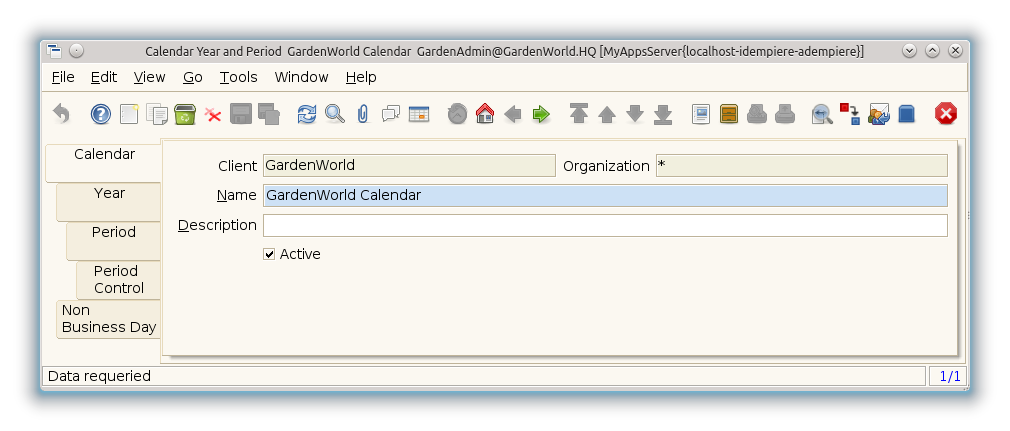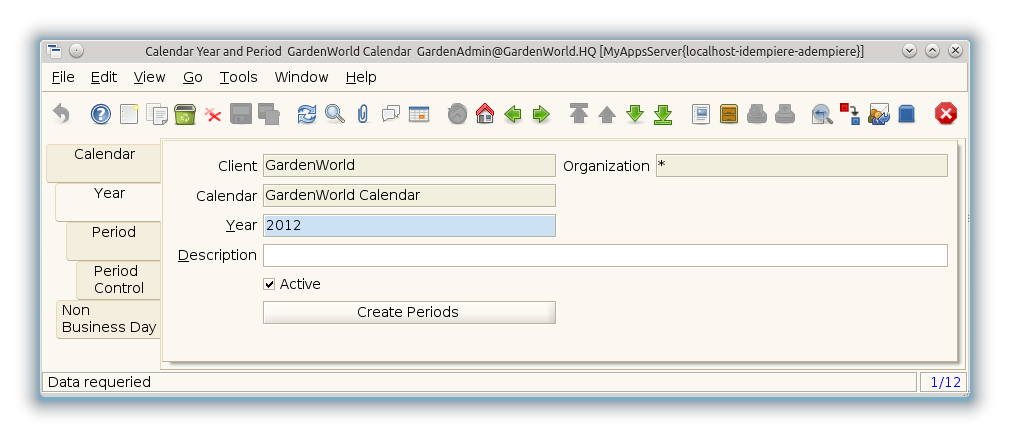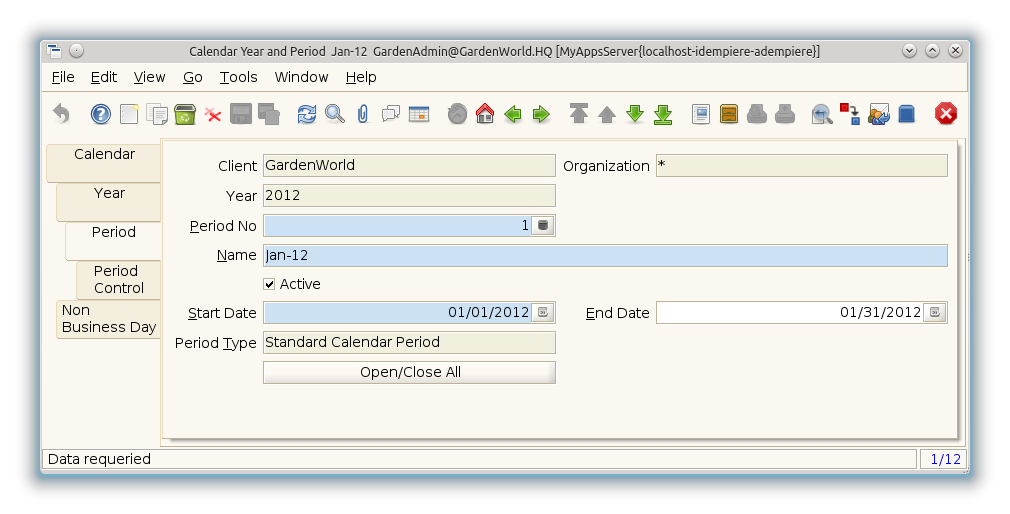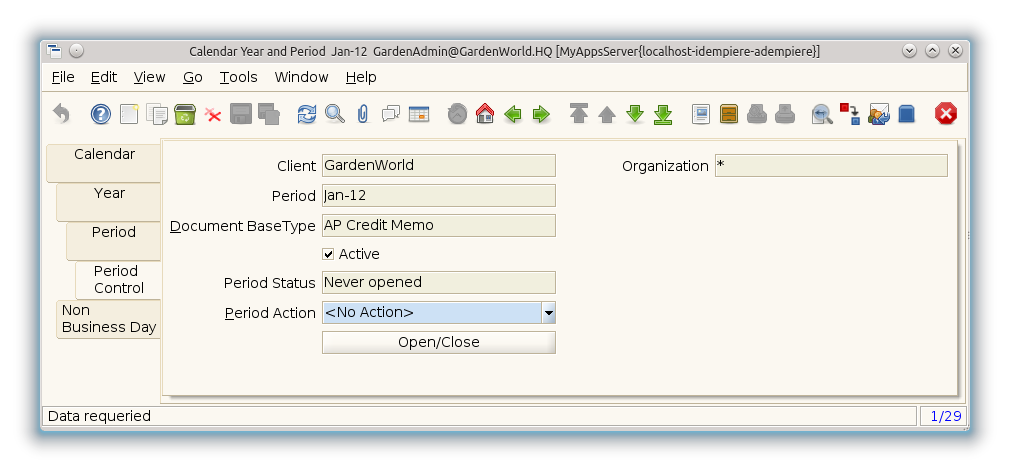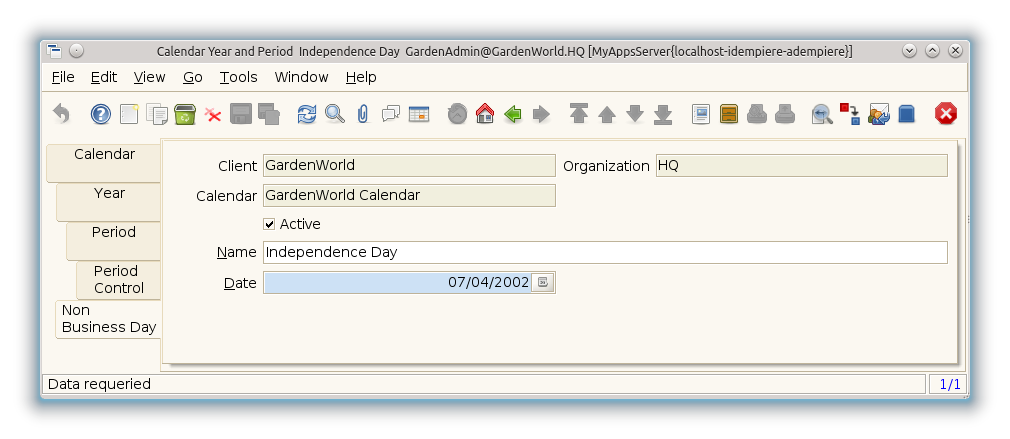Calendar Year and Period (Window ID-117)
Window: Calendar Year and Period
Description: Maintain Calendars Years Periods
Help: The Calendar Year and Periods defines the calendars that will be used for period control and reporting. You can also define non-standard calendars (e.g. business year from July to June).
Tab: Calendar
Description: Define your calendar
Help: The Calendar Tab defines each calendar that will be used by an Organization.
| Name | Description | Help | Technical Data |
|---|---|---|---|
| Tenant | Tenant for this installation. | A Tenant is a company or a legal entity. You cannot share data between Tenants. | C_Calendar.AD_Client_ID numeric(10) Table Direct |
| Organization | Organizational entity within tenant | An organization is a unit of your tenant or legal entity - examples are store, department. You can share data between organizations. | C_Calendar.AD_Org_ID numeric(10) Table Direct |
| Name | Alphanumeric identifier of the entity | The name of an entity (record) is used as an default search option in addition to the search key. The name is up to 60 characters in length. | C_Calendar.Name character varying(60) String |
| Description | Optional short description of the record | A description is limited to 255 characters. | C_Calendar.Description character varying(255) String |
| Active | The record is active in the system | There are two methods of making records unavailable in the system: One is to delete the record, the other is to de-activate the record. A de-activated record is not available for selection, but available for reports.
There are two reasons for de-activating and not deleting records: (1) The system requires the record for audit purposes. (2) The record is referenced by other records. E.g., you cannot delete a Business Partner, if there are invoices for this partner record existing. You de-activate the Business Partner and prevent that this record is used for future entries. |
C_Calendar.IsActive character(1) Yes-No |
Tab: Year
Description: Define Calendar Year
Help: The Year Window is used to define each year for the specified calendar.
| Name | Description | Help | Technical Data |
|---|---|---|---|
| Tenant | Tenant for this installation. | A Tenant is a company or a legal entity. You cannot share data between Tenants. | C_Year.AD_Client_ID numeric(10) Table Direct |
| Organization | Organizational entity within tenant | An organization is a unit of your tenant or legal entity - examples are store, department. You can share data between organizations. | C_Year.AD_Org_ID numeric(10) Table Direct |
| Calendar | Accounting Calendar Name | The Calendar uniquely identifies an accounting calendar. Multiple calendars can be used. For example you may need a standard calendar that runs from Jan 1 to Dec 31 and a fiscal calendar that runs from July 1 to June 30. | C_Year.C_Calendar_ID numeric(10) Table Direct |
| Year | The Fiscal Year | The Year identifies the accounting year for a calendar. | C_Year.FiscalYear character varying(10) String |
| Description | Optional short description of the record | A description is limited to 255 characters. | C_Year.Description character varying(255) String |
| Active | The record is active in the system | There are two methods of making records unavailable in the system: One is to delete the record, the other is to de-activate the record. A de-activated record is not available for selection, but available for reports.
There are two reasons for de-activating and not deleting records: (1) The system requires the record for audit purposes. (2) The record is referenced by other records. E.g., you cannot delete a Business Partner, if there are invoices for this partner record existing. You de-activate the Business Partner and prevent that this record is used for future entries. |
C_Year.IsActive character(1) Yes-No |
| Create Periods | Create 12 standard calendar periods. | Creates 12 calendar month long standard periods from the specified start date. If no start date is specified, 1st of Jan will be used. The period name will be generated from the start date of each period using the java SimpleDateFormat pattern provided. | C_Year.Processing character(1) Button |
Tab: Period
Description: Define Calendar Periods
Help: The Period Tab defines a Period No, Name and Start Date for each Calendar Year. Each period begins on the defined Start Date and ends one day prior to the next period's Start Date.
| Name | Description | Help | Technical Data |
|---|---|---|---|
| Tenant | Tenant for this installation. | A Tenant is a company or a legal entity. You cannot share data between Tenants. | C_Period.AD_Client_ID numeric(10) Table Direct |
| Organization | Organizational entity within tenant | An organization is a unit of your tenant or legal entity - examples are store, department. You can share data between organizations. | C_Period.AD_Org_ID numeric(10) Table Direct |
| Year | Calendar Year | The Year uniquely identifies an accounting year for a calendar. | C_Period.C_Year_ID numeric(10) Table Direct |
| Period No | Unique Period Number | The Period No identifies a specific period for this year. Each period is defined by a start and end date. Date ranges for a calendar and year cannot overlap. | C_Period.PeriodNo numeric(10) Integer |
| Name | Alphanumeric identifier of the entity | The name of an entity (record) is used as an default search option in addition to the search key. The name is up to 60 characters in length. | C_Period.Name character varying(60) String |
| Active | The record is active in the system | There are two methods of making records unavailable in the system: One is to delete the record, the other is to de-activate the record. A de-activated record is not available for selection, but available for reports.
There are two reasons for de-activating and not deleting records: (1) The system requires the record for audit purposes. (2) The record is referenced by other records. E.g., you cannot delete a Business Partner, if there are invoices for this partner record existing. You de-activate the Business Partner and prevent that this record is used for future entries. |
C_Period.IsActive character(1) Yes-No |
| Start Date | First effective day (inclusive) | The Start Date indicates the first or starting date | C_Period.StartDate timestamp without time zone Date |
| End Date | Last effective date (inclusive) | The End Date indicates the last date in this range. | C_Period.EndDate timestamp without time zone Date |
| Period Type | Period Type | The Period Type indicates the type (Standard or Adjustment) of period. | C_Period.PeriodType character(1) List |
| Open/Close All | Change Period Status for all Period Controls of this Period | C_Period.Processing character(1) Button |
Tab: Period Control
Description: Define Period Control
Help: The Period Control Tab displays the status of a Period (Never Opened, Opened, Closed).
| Name | Description | Help | Technical Data |
|---|---|---|---|
| Tenant | Tenant for this installation. | A Tenant is a company or a legal entity. You cannot share data between Tenants. | C_PeriodControl.AD_Client_ID numeric(10) Table Direct |
| Organization | Organizational entity within tenant | An organization is a unit of your tenant or legal entity - examples are store, department. You can share data between organizations. | C_PeriodControl.AD_Org_ID numeric(10) Table Direct |
| Period | Period of the Calendar | The Period indicates an exclusive range of dates for a calendar. | C_PeriodControl.C_Period_ID numeric(10) Table Direct |
| Document Base Type | Logical type of document | The Document Base Type identifies the base or starting point for a document. Multiple document types may share a single document base type. | C_PeriodControl.DocBaseType character(3) List |
| Active | The record is active in the system | There are two methods of making records unavailable in the system: One is to delete the record, the other is to de-activate the record. A de-activated record is not available for selection, but available for reports.
There are two reasons for de-activating and not deleting records: (1) The system requires the record for audit purposes. (2) The record is referenced by other records. E.g., you cannot delete a Business Partner, if there are invoices for this partner record existing. You de-activate the Business Partner and prevent that this record is used for future entries. |
C_PeriodControl.IsActive character(1) Yes-No |
| Period Status | Current state of this period | The Period Status indicates the current status for this period. For example 'Closed', 'Open', 'Never Opened'. | C_PeriodControl.PeriodStatus character(1) List |
| Period Action | Action taken for this period | The Period Action indicates the action to be taken for this period. For example 'Close Period' or 'Open Period'. | C_PeriodControl.PeriodAction character(1) List |
| Open/Close | Change Period Status | C_PeriodControl.Processing character(1) Button |
Tab: Non Business Day
Description: Define Non Business Days
Help: The Non Business Days Tab defines those days to exclude when calculating the due date for given payment terms. For example, if an invoice terms was Net 10 days and the Invoice Date was 2/17/2000 the due date would be 2/27/2000. If 2/27/2000 was defined as a non business day then the due date on the Invoice would be 2/28/2000.
| Name | Description | Help | Technical Data |
|---|---|---|---|
| Tenant | Tenant for this installation. | A Tenant is a company or a legal entity. You cannot share data between Tenants. | C_NonBusinessDay.AD_Client_ID numeric(10) Table Direct |
| Organization | Organizational entity within tenant | An organization is a unit of your tenant or legal entity - examples are store, department. You can share data between organizations. | C_NonBusinessDay.AD_Org_ID numeric(10) Table Direct |
| Calendar | Accounting Calendar Name | The Calendar uniquely identifies an accounting calendar. Multiple calendars can be used. For example you may need a standard calendar that runs from Jan 1 to Dec 31 and a fiscal calendar that runs from July 1 to June 30. | C_NonBusinessDay.C_Calendar_ID numeric(10) Table Direct |
| Active | The record is active in the system | There are two methods of making records unavailable in the system: One is to delete the record, the other is to de-activate the record. A de-activated record is not available for selection, but available for reports.
There are two reasons for de-activating and not deleting records: (1) The system requires the record for audit purposes. (2) The record is referenced by other records. E.g., you cannot delete a Business Partner, if there are invoices for this partner record existing. You de-activate the Business Partner and prevent that this record is used for future entries. |
C_NonBusinessDay.IsActive character(1) Yes-No |
| Name | Alphanumeric identifier of the entity | The name of an entity (record) is used as an default search option in addition to the search key. The name is up to 60 characters in length. | C_NonBusinessDay.Name character varying(60) String |
| Date | Date when business is not conducted | The Date field identifies a calendar date on which business will not be conducted. | C_NonBusinessDay.Date1 timestamp without time zone Date |
| Country | Country | The Country defines a Country. Each Country must be defined before it can be used in any document. | C_NonBusinessDay.C_Country_ID numeric(10) Table Direct |

